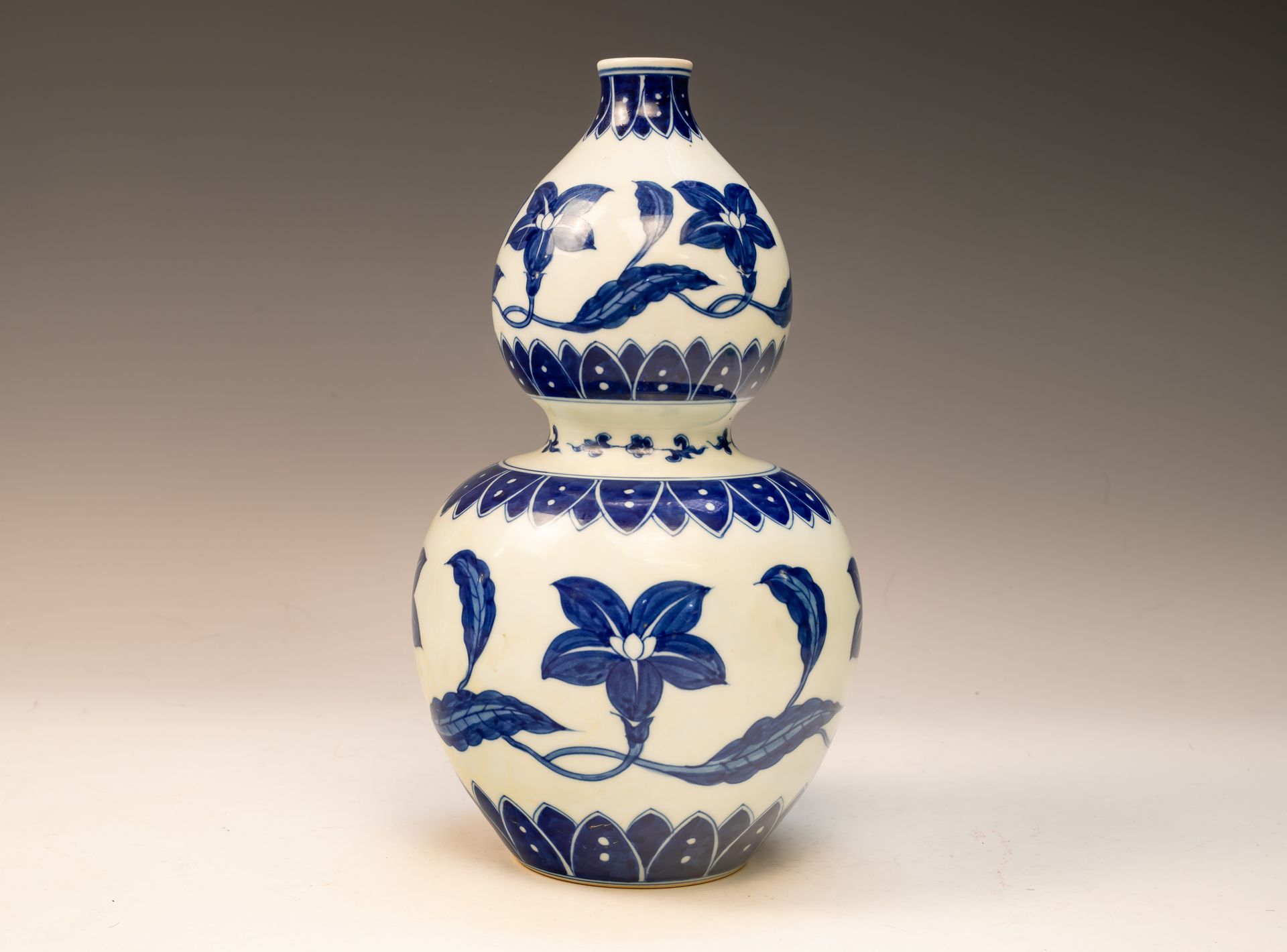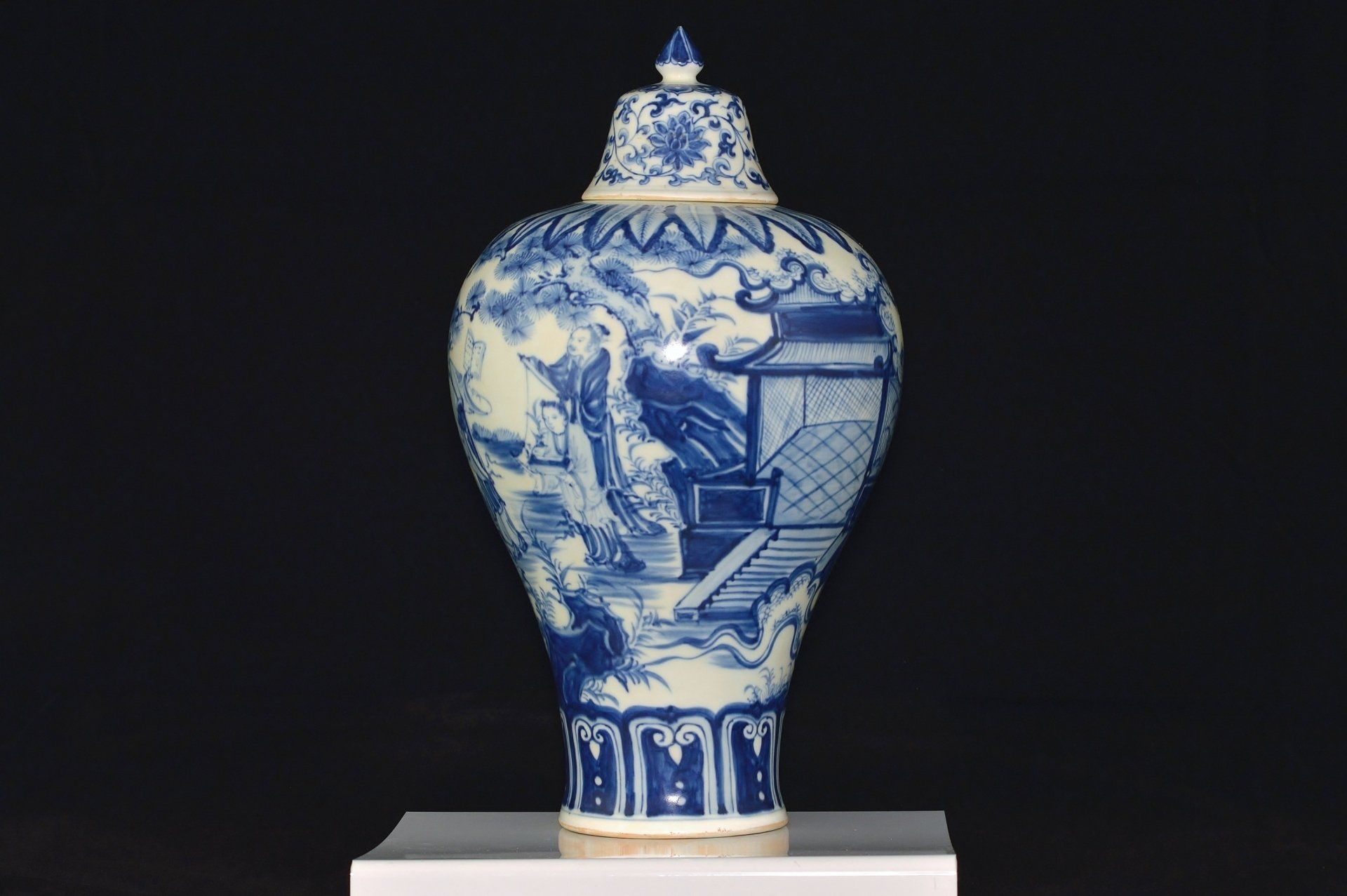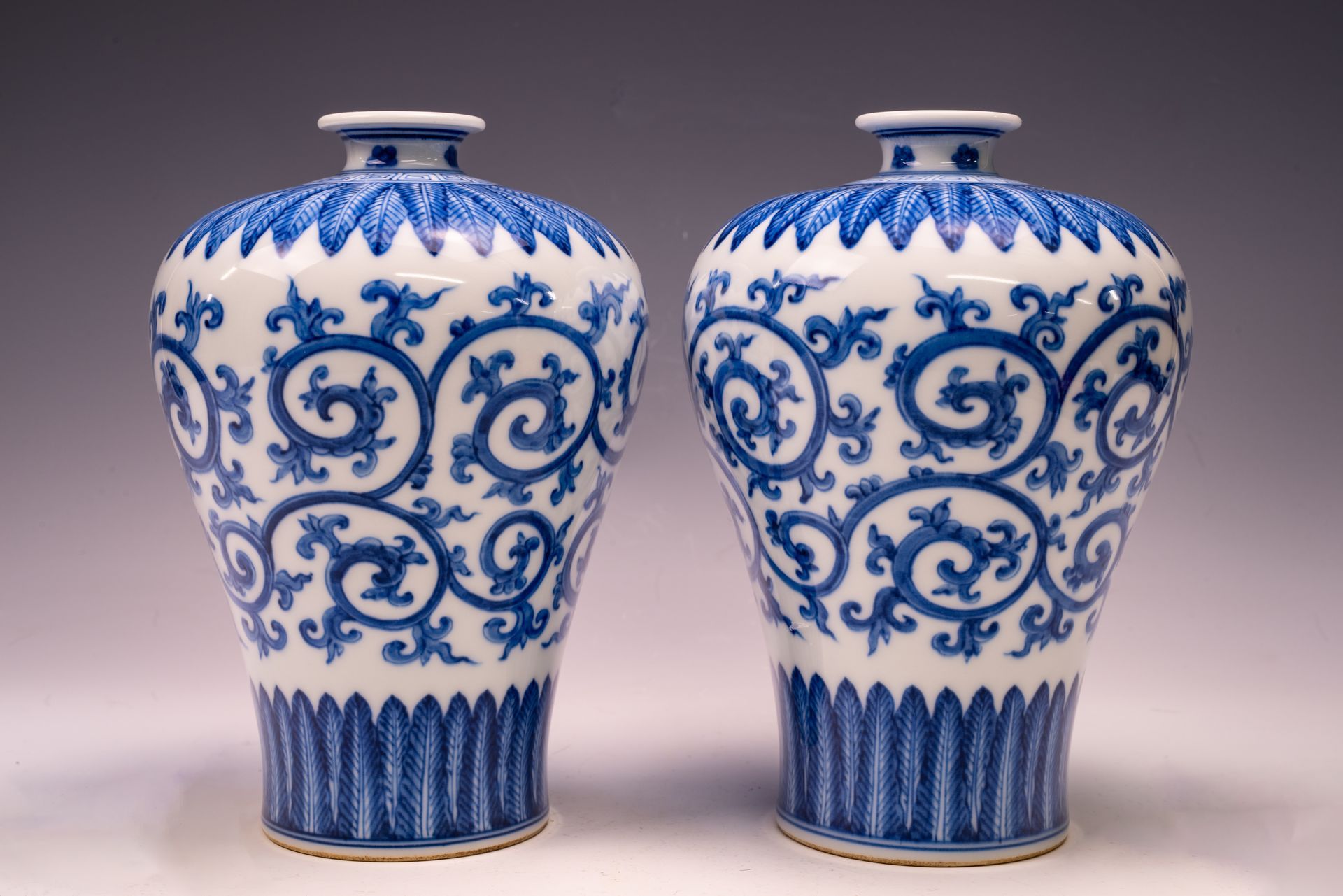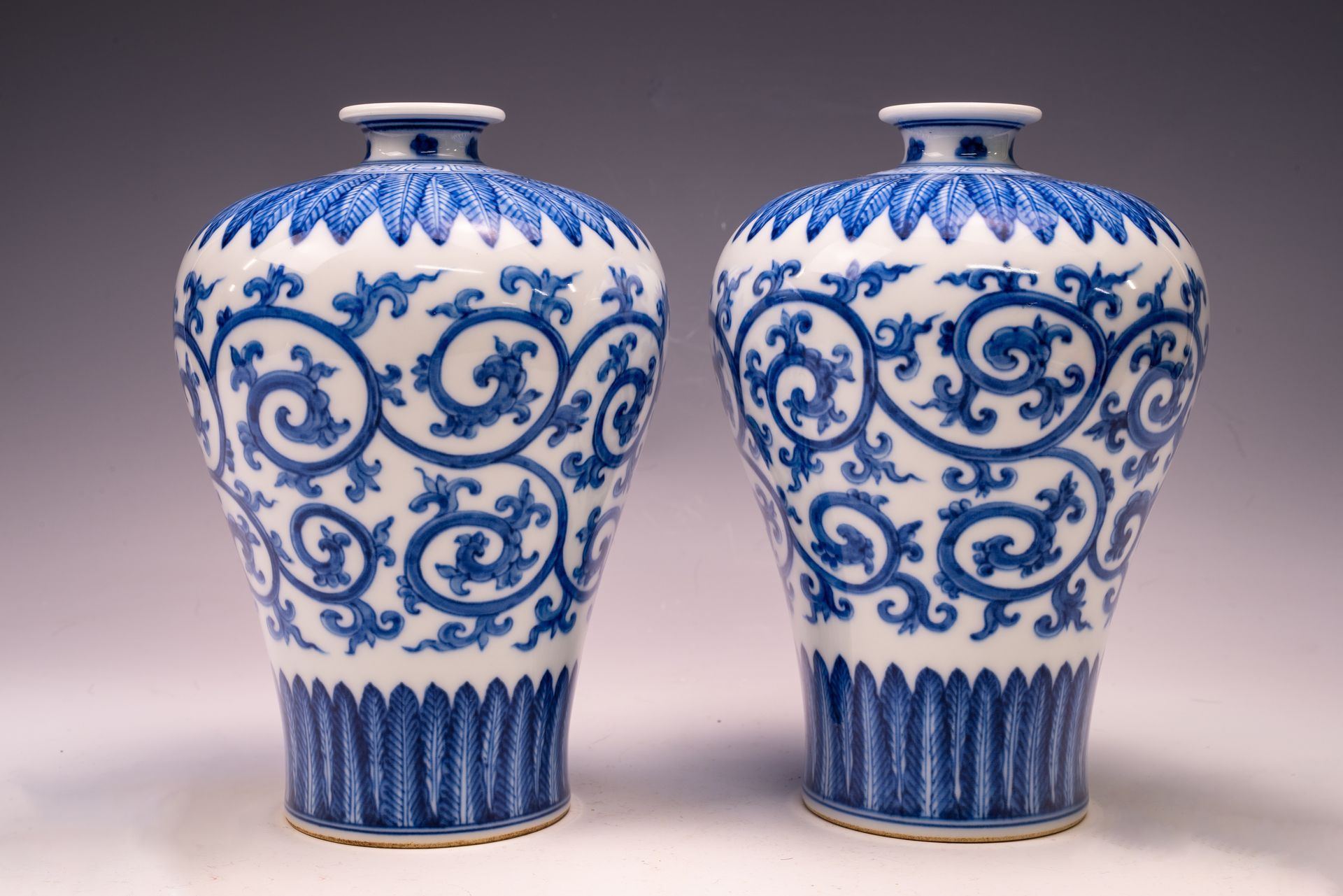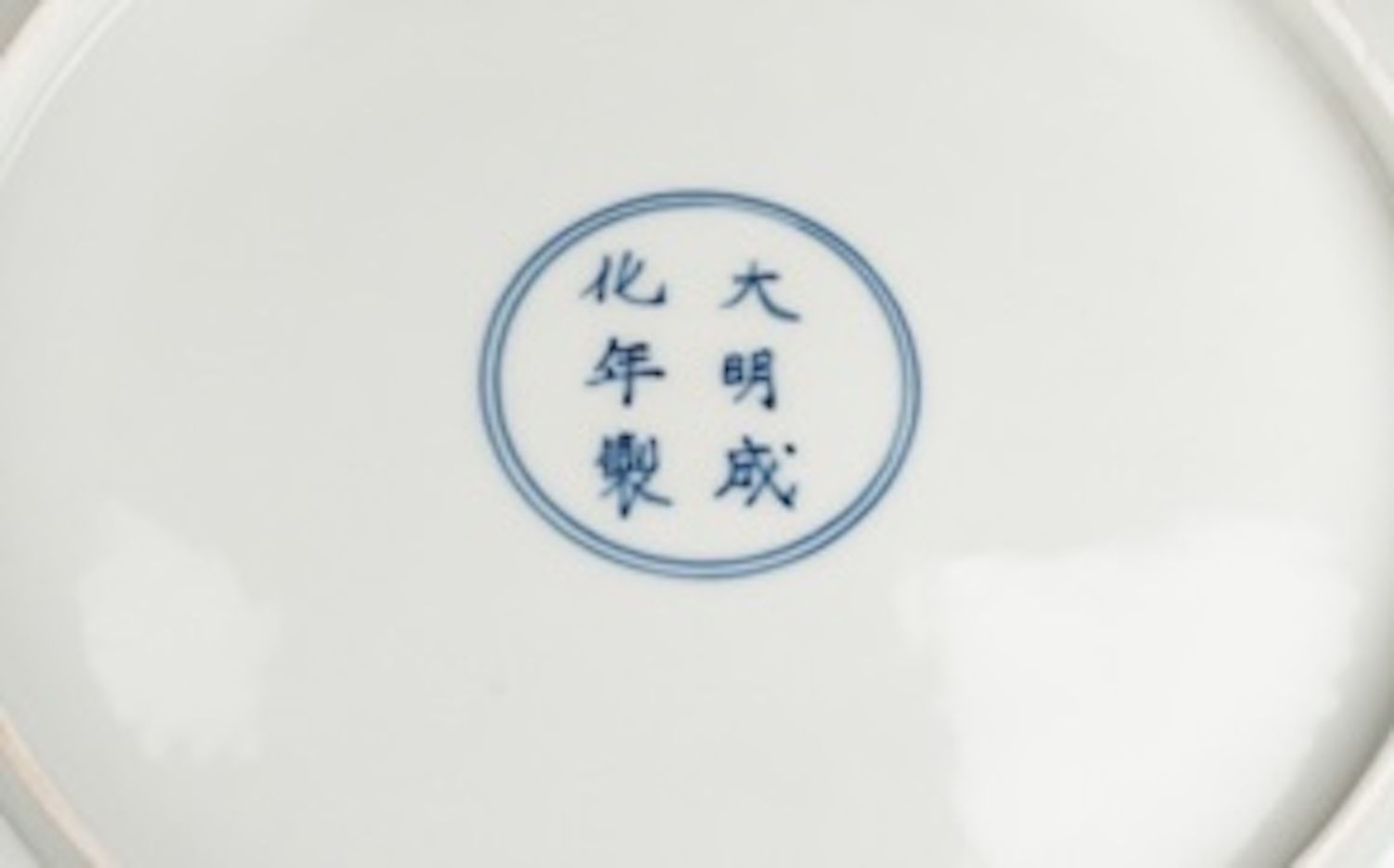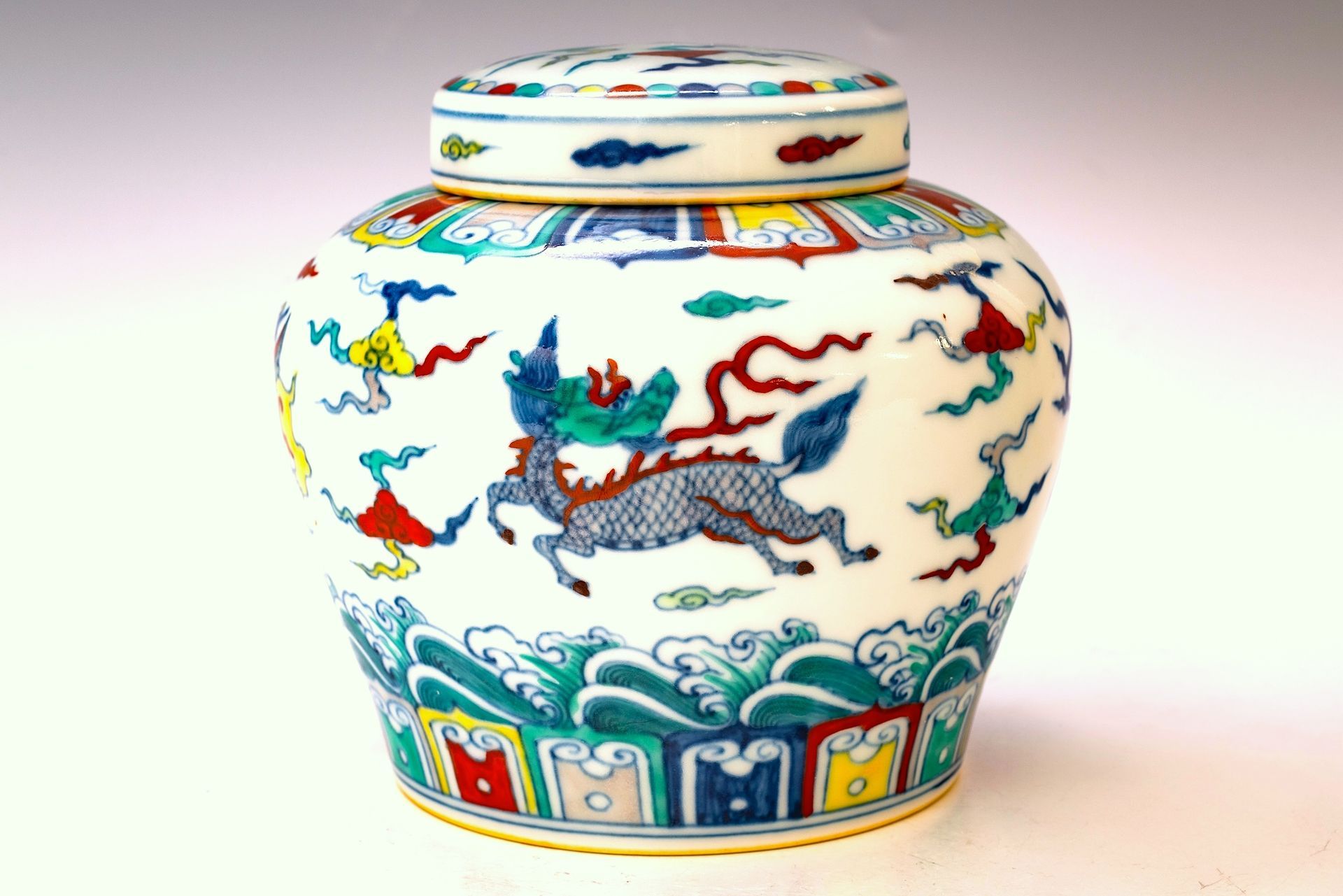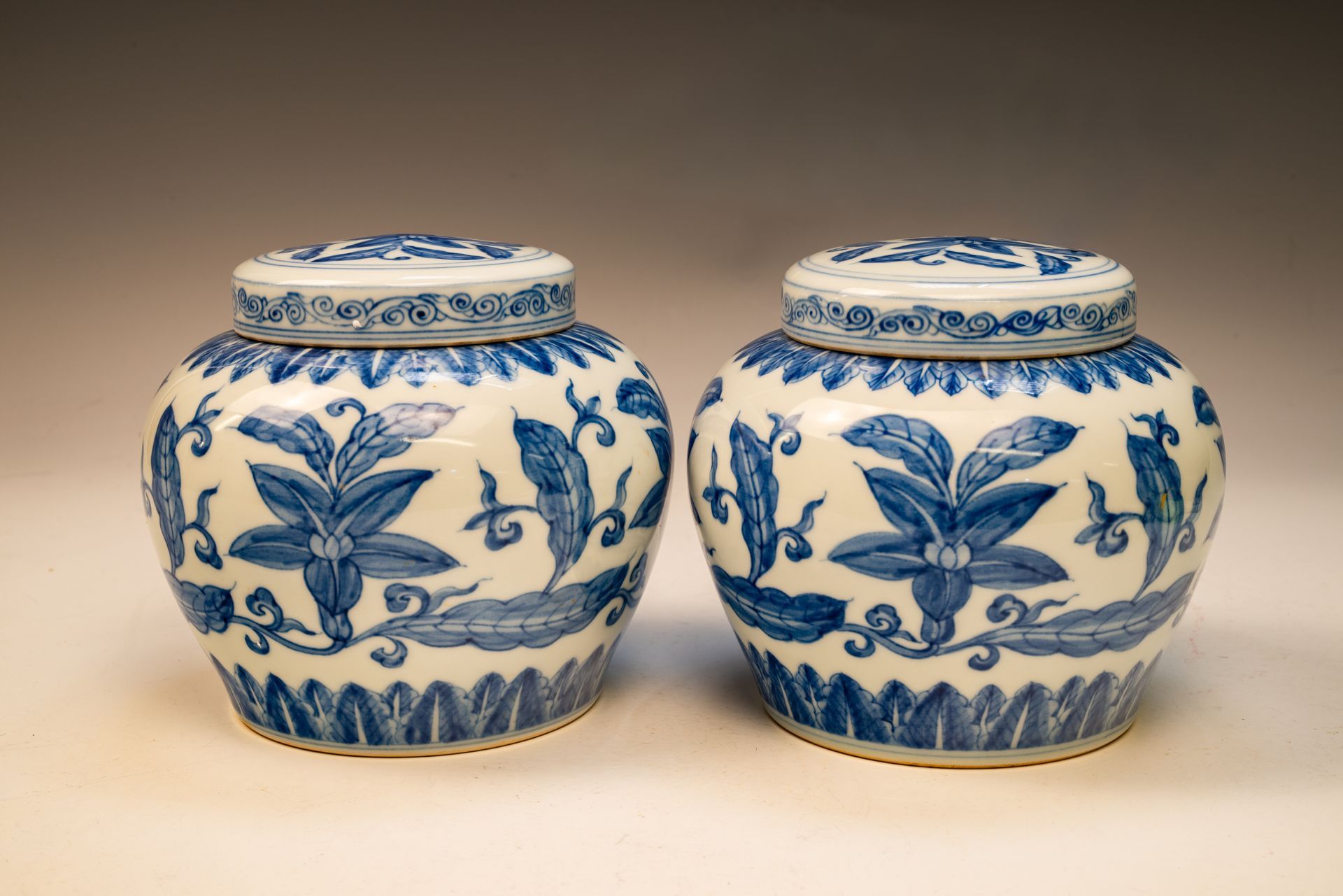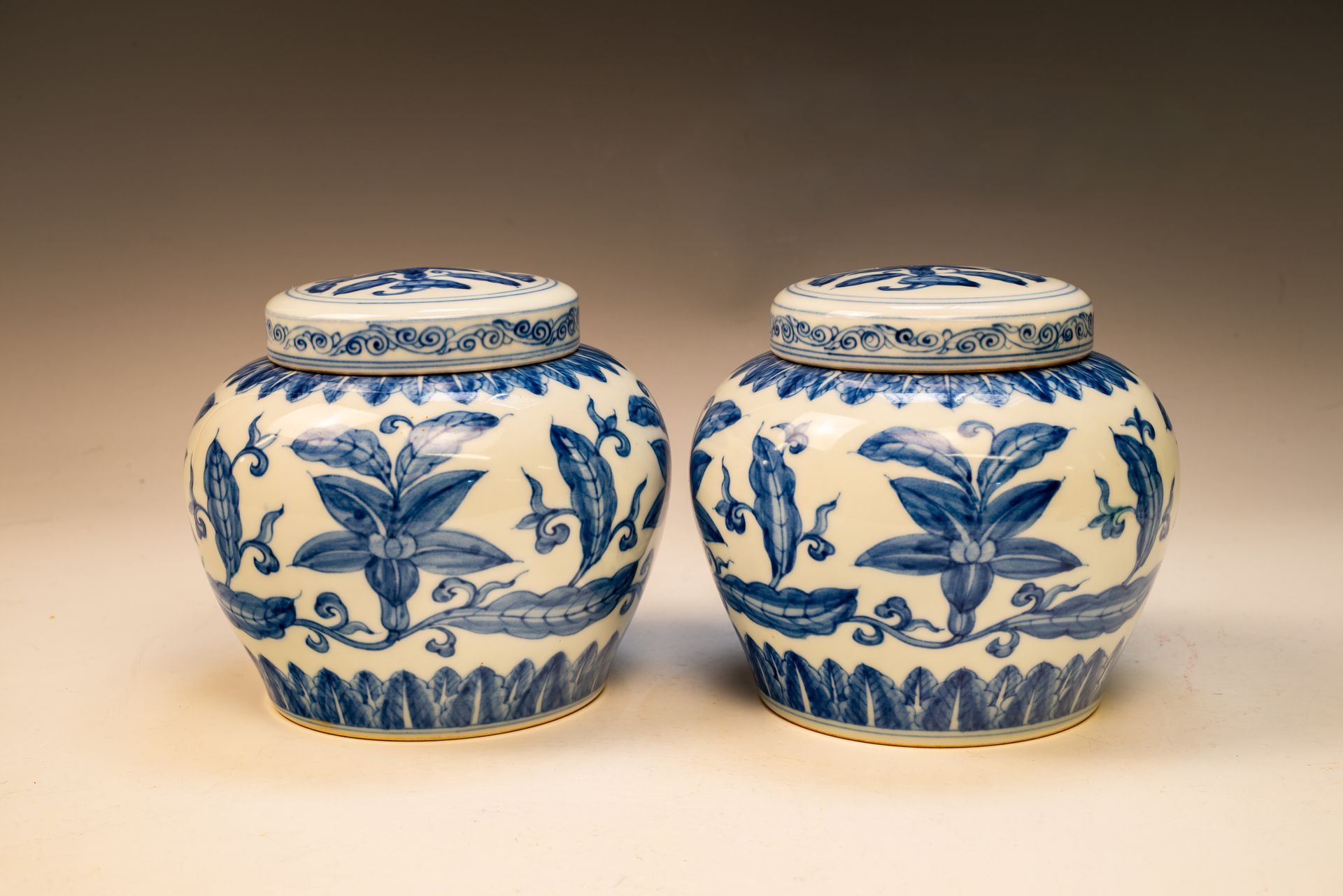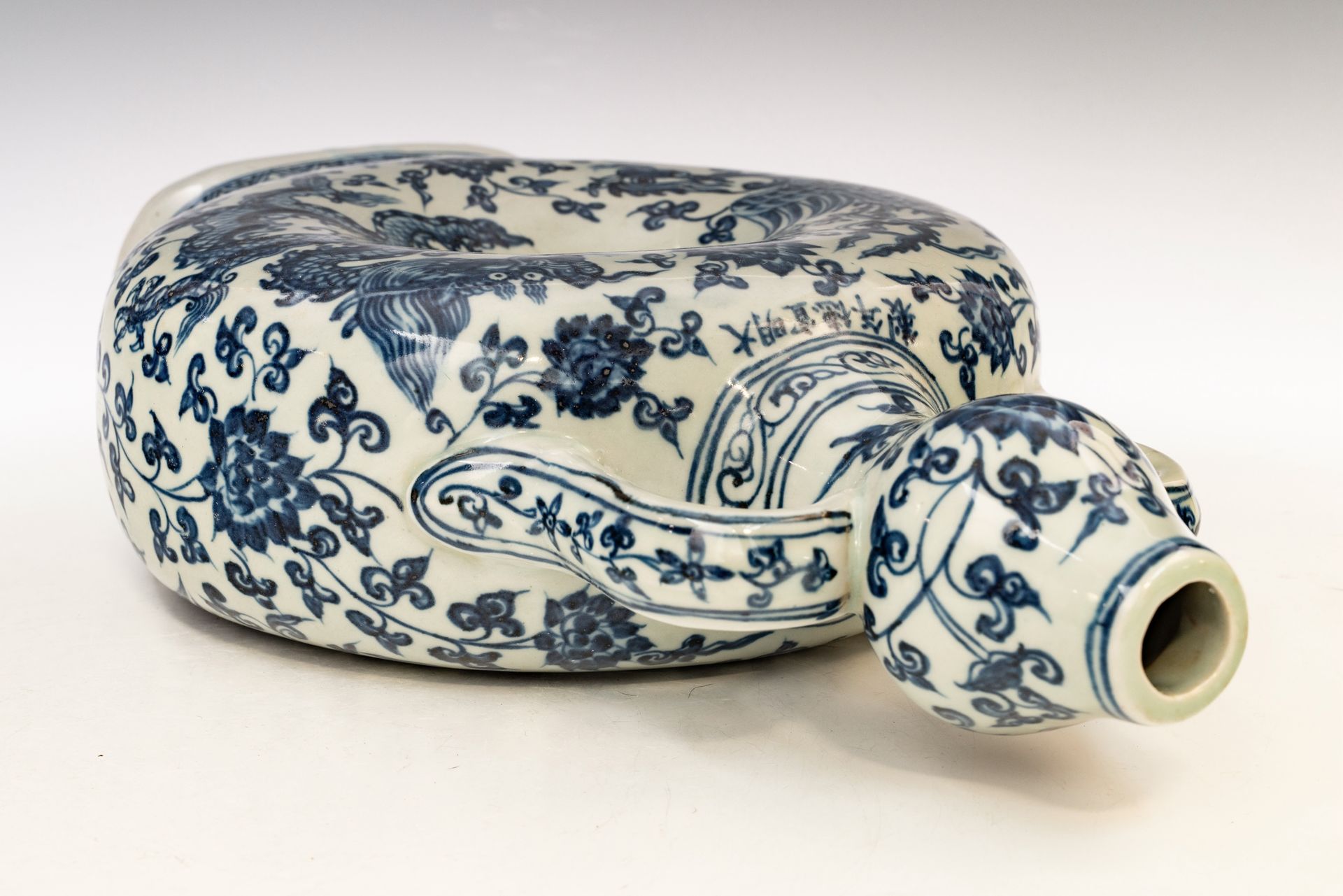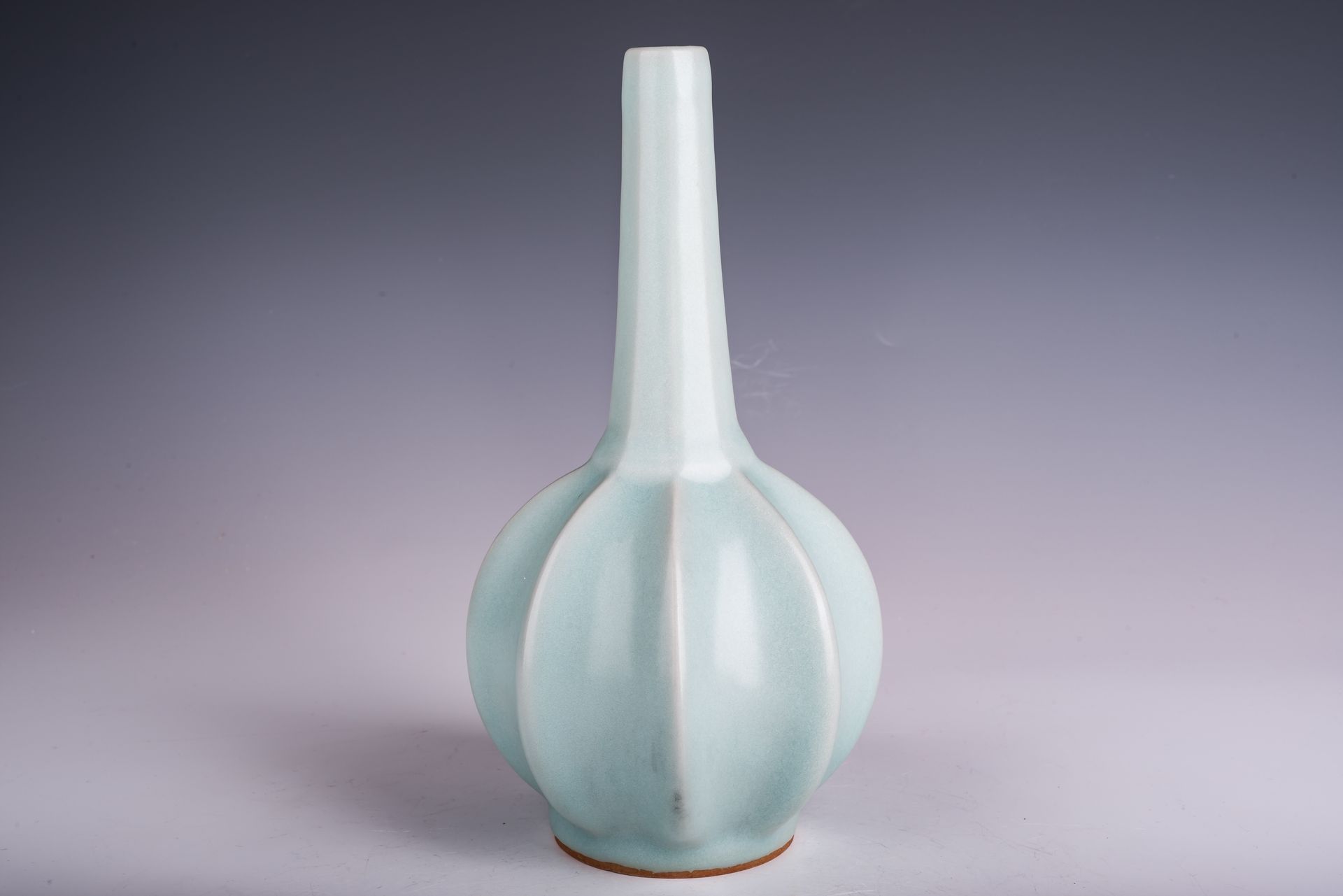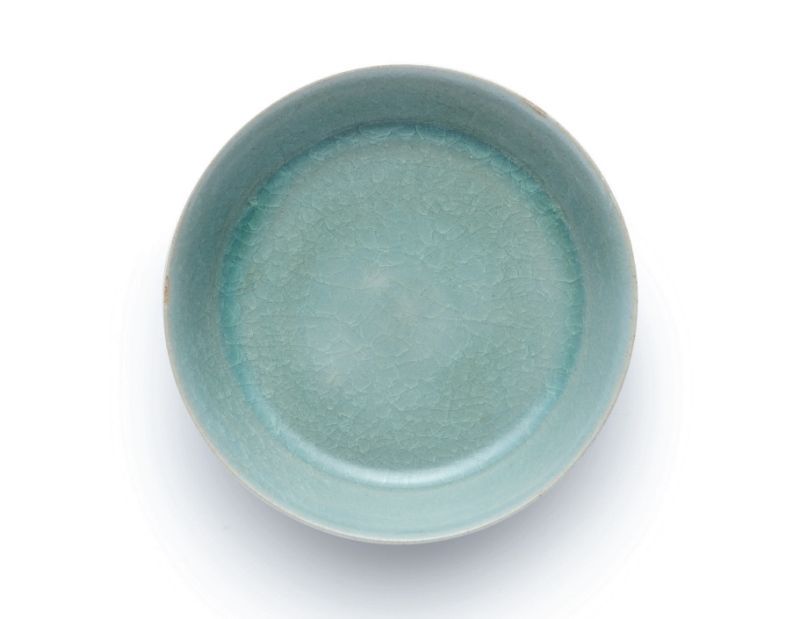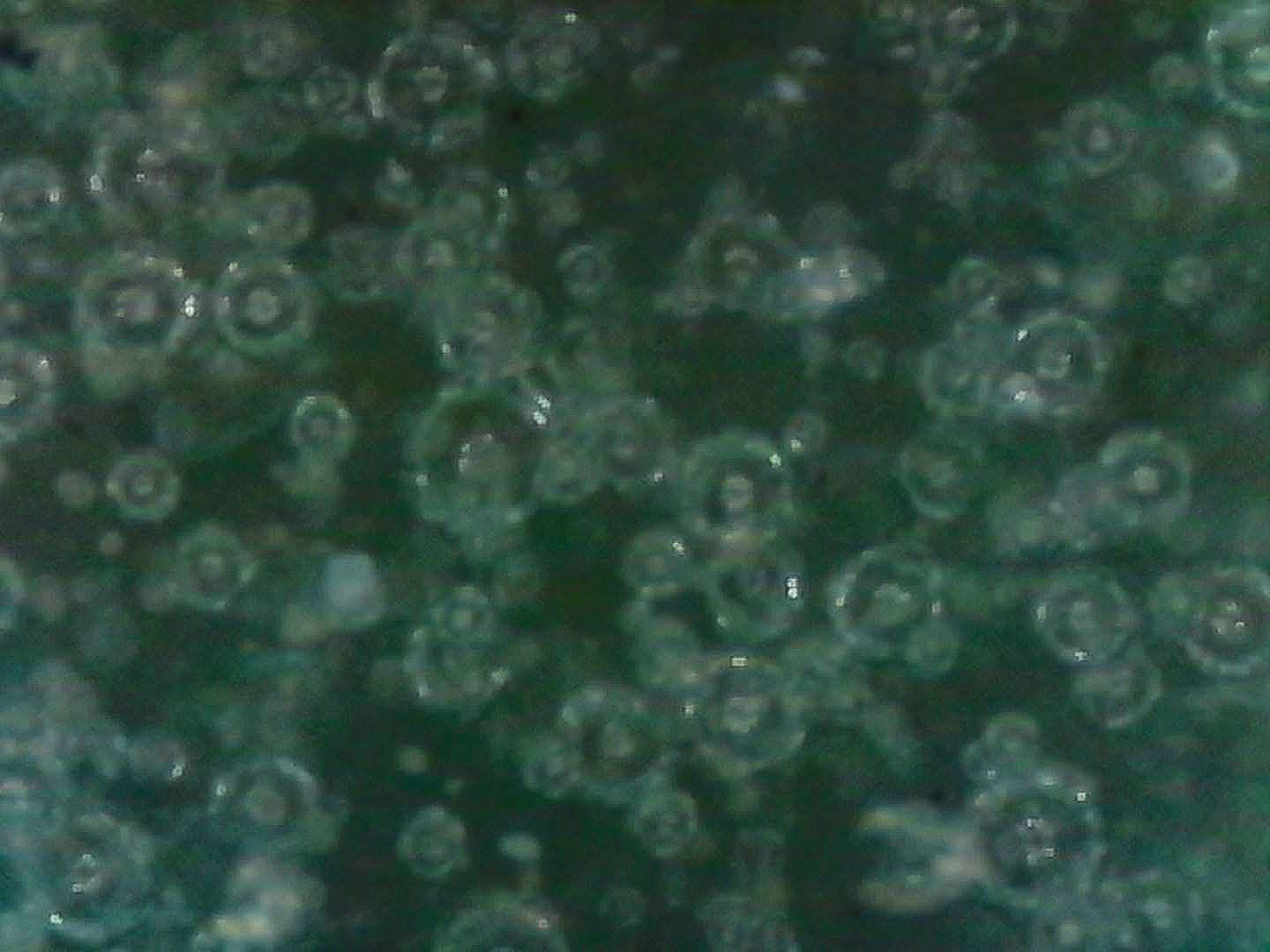Chinese Masterpieces
Fine Important Imperial Ming Dynasty Porcelain
If you're interested in purchasing any piece on this site or
For All Enquiries, Please Contact
AGENT : Venizelos G. Gavrilakis, President, VENIS STUDIOS
Venizelos@chinesemasterpieces.com tel:+971 50 683 5877
Exceptional Cloisonné Jar and Lid with Fish Motif from the Ming Dynasty, Mark and Period of Jiajing
This exceptional Jiajing Cloisonné Fish Jar with Lid, distinguished by its remarkable rarity and importance, originates from the Ming Dynasty. The Jiajing period, spanning from 1522 to 1566, is renowned for its exquisite Fish Jars, and this particular piece exemplifies the mastery of cloisonné craftsmanship. The jar exhibits minor flaking in the biscuit, a testament to its historical authenticity. This extraordinary work of art stands at an impressive height of 15 1/2 inches. ppjrs
(click image to enlarge)
Contact me for the Price
Imperial Blue and White Ming Dynasty Jiajing Mark and Period Jar and Lid Featuring Fish Amidst Aquatic Vegetation
This exceptional jar, originating from the Ming Dynasty and specifically produced during the Jiajing period (1522-1566), is a finely crafted blue and white Guan jar featuring a motif of fish among aquatic weeds. Notably, the Jiajing era is characterized by the use of imported Mohammedan blue cobalt, which was distinguished by its unique purple hue and became increasingly scarce by the early 17th century. The jar displays evidence of age through flaking in the biscuit, enhancing its authenticity and historical significance. This exquisite piece stands at a height of 15 1/4 inches. ppjrs
(click image to enlarge)
Contact me for the Price
Imperial Blue and White Early 15th Century Ming Dynasty Xuande Period Dragon Motif Globular Vase with Extensive Inscriptions
Ming Dynasty Xuande, Early 15th Century, Blue and White Globular Vase Featuring a Dragon and Extensive Inscription. This exquisite globular vase showcases a five-clawed dragon gracefully soaring through the clouds in pursuit of a flaming pearl. The vase is adorned with imported Samali blue cobalt, renowned for its distinctive blackish hue. Notably, the heaping and piling effects on the surface of the glaze may reveal black spots or silvery reflections; conversely, any brown coloration would indicate the use of local Chinese cobalt. This distinction serves as evidence of its age, as imported cobalt has not been accessible for over 500 years. Furthermore, the presence of flaking in the biscuit reinforces the vase’s historical significance. The dimensions of this Xuande globular vase are approximately
17 3/8 inches in height. ppjrs
(click image to enlarge)
Contact me for the Price
Exceptional Imperial Blue and White Double Gourd Lily Vase from the 15th Century Ming Dynasty, Chenghua Mark and Period
This extraordinary artifact is a Blue and White Double Gourd Lily Vase hailing from the Chenghua period, crafted during the Ming Dynasty between 1465 and 1487. It is distinguished by its intricate painting in deep cobalt blue, featuring seven segments adorned with lappets, scrolling lilies, and leaves. The vase stands at approximately 9 3/8 inches in height. For those in the realms of collecting and connoisseurship, it is prudent to consult auction catalogs, academic texts, and museum collections, as a comparable Chenghua Double Gourd vase has seldom been published or exhibited. The vase exemplifies a remarkable form and a striking dark blue hue, enhanced by masterfully executed freestyle brushstrokes typical of the preeminent Chenghua ceramics. Artisans of this period were celebrated for their precise application of fine outlines coupled with broad brushstrokes. The blue and white wares produced during this revered era are among the most sought-after examples of Chinese porcelain. A defining characteristic of this piece is the exceptional cobalt pigment, which provides a unique blackish tone derived from imported cobalt, believed to be samali blue from Persia. Notably, this specific shade of cobalt has not been imported for over five centuries, underscoring the rarity of such items. Additionally, local cobalt known as Pitang was employed, and the combination of these pigments resulted in a wide array of refined hues. The advanced refinement of the clay and the high-temperature kilns from this period contributed to distinctive traits, including occasional burning or mottling found on the unglazed bottoms of larger vessels. When glazed, certain bases may exhibit a wavy contour, particularly under illumination. This specific glaze is of exceptional quality, characterized by tiny, uniform bubbles discernible with a loupe, further attesting to its authenticity and age. The presence of flaking in the biscuit speaks to the vase's historical significance, showcasing the pinnacle of Imperial blue and white Chenghua wares, a category unmatched in artistry and excellence. ppjrs
(click image to enlarge)
Contact me for the Price
Imperial Blue and White Ming Dynasty 15th Century Chenghua Windswept Mark and Period Figure Jar
This exceptional piece is a noteworthy example of an Imperial Ming Dynasty blue and white guan jar, specifically dating back to the 15th century and marked from the Chenghua period (1465-1487). The jar features four distinct decorative panels: the first showcases lotus leaves; the second depicts water with horses soaring amidst clouds; the principal panel illustrates a narrative scene accompanied by a six-character Chenghua mark; while the base presents a water-themed design. The craftsmanship is evident in the dynamic portrayal of the figures, particularly the flowing robes that suggest movement in the wind. Furthermore, the original method of joining the jar can be discerned from visible luting marks. The base exhibits a mottled appearance, indicating a degree of burning during the firing process. The overall height of the piece is approximately 11 3/4 inches. Chenghua blue and white ceramics are renowned as the most desirable examples produced in China, distinguished by the exquisite cobalt blue pigment characteristic of this era. The cobalt used is notable for its distinct blackish hue, derived from imported Somali blue cobalt, which was blended with locally sourced cobalt called Pitang to enhance stability, minimizing the risk of color running. Unlike vessels from previous periods, Chenghua ceramics typically avoid the heaping and piling effects due to the meticulous refinement of their cobalt. This cobalt, historically sourced from Persia, has not been imported into China for over five centuries since the conclusion of the Chenghua period. Chenghua wares are recognized for their fine outlines and broad brush strokes that exhibit a spontaneous style. The clay composition was superior to that of earlier periods, and the use of high-firing kilns resulted in larger pieces often showcasing unglazed bottoms with a burnt or mottled finish, while glazed bases may appear undulating. Upon close inspection, the glaze displays a uniform surface with minute bubbles visible under magnification. This particular piece also demonstrates signs of flaking in the biscuit body, further confirming its age and authenticity.
( click image to enlarge)
Contact me for the Price
Significant Imperial Blue and White Meiping Story Vase from the 15th Century Ming Dynasty, Chenghua Mark and Period
This exceptional masterpiece represents a Blue and White Meiping Story Vase from the Chenghua period, marked and produced during the reign of the Ming Dynasty, specifically between 1465 and 1487. The vase stands approximately 13 3/4 inches tall. For collectors and connoisseurs, it is advisable to reference auction catalogs, scholarly texts, and museum collections, as it is unlikely that a comparable Chenghua Meiping vase has been published or exhibited elsewhere. The vase showcases a remarkable form and vibrant color, adorned with expertly executed freestyle brushstrokes characteristic of the finest Chenghua ceramics. The blue and white wares produced during this esteemed period are among the most coveted examples of Chinese porcelain. The exceptional cobalt pigment utilized is a distinguishing feature, providing a unique blackish tone derived from imported cobalt, believed to be samali blue from Persia. This specific cobalt has not been imported for over five centuries, marking the rarity of such pieces. In addition, a local cobalt known as Pitang was employed, with the combination of both pigments yielding a variety of refined hues. Chenghua artisans were notable for their meticulous use of fine outlines filled in with broad strokes. The refinement of clay and the high-temperature kilns of this era contributed to distinct characteristics, including occasional burning or mottling visible on the unglazed bottoms of larger vessels. When glazed, some bottoms may exhibit a wavy appearance, particularly under light. This particular glaze is exceptionally fine, featuring tiny, uniform bubbles identifiable through the use of a loupe, further confirming its authenticity and age. The presence of flaking in the biscuit underscores the vase's historical significance. It is a testament to the pinnacle of Imperial blue and white Chenghua wares, a category unparalleled in its artistry and quality.
(click image to enlarge
Contact me for the Price
Significant Imperial Blue and White Jar from the 15th Century Ming Dynasty, Chenghua Mark and Period
This exquisite artifact, known as the Blue and White Ming Dynasty Chenghua Mark and Period Imperial Buddhist Lion Jar, exemplifies the artistry of the Chenghua period, which spanned from 1465 to 1487. Measuring approximately 5 1/8 inches in height, this jar is a quintessential representation of the highly coveted Chenghua wares. Its delicate craftsmanship showcases an extraordinary level of skill and precision that truly merits in-person observation to fully appreciate the artistic mastery involved in its creation during the Ming Dynasty. Upon consulting auction catalogs, scholarly texts, and museum collections, one will find it difficult to locate a comparable example of a Chenghua Jar available in the marketplace. The jar features a sophisticated form and vibrant coloration, adorned with remarkably controlled freestyle brushwork, executed with what appears to be minimalistic hairbrush strokes. This attention to detail is emblematic of the finest Chenghua wares. The decorative motifs include four Buddhist Lions and various Buddhist symbols. An examination through a jeweler’s loupe reveals noticeable flaking in the biscuit, an indicator of the jar's significant age. Among Chinese ceramics, blue and white wares from this period are among the most sought after, distinguished by the stunning cobalt blue hues that are characteristic of Chenghua production. The cobalt utilized during this dynasty has a distinct blackish tone, derived from imported Samali blue cobalt believed to have originated in Persia, though the specific source remains uncertain and has not been imported for over five centuries. In addition, local cobalt known as Pitang was employed. The mixing of these two cobalt types resulted in a refined palette of colors that defined the aesthetic quality of Chenghua wares. Artisans of this period skillfully painted fine outlines filled in with broad brushstrokes, demonstrating a unique approach to composition. The refinement of clay and the use of high-firing kilns often resulted in aesthetic peculiarities, such as a mottled appearance on the undersides of larger vessels or wavy glaze textures discernible under reflective light. This particular glaze is easily identifiable due to its fine quality and the presence of minute, even bubbles observable with a magnifying lens. In summary, the true Imperial blue and white Chenghua wares represent the pinnacle of ceramic artistry within the Ming Dynasty, and this jar stands as a testament to that legacy.
(click image to enlarge)
Contact me for the Price
Imperial Pair of Blue and White Vases from the 15th Century Ming Dynasty, Marked and Period Chenghua
This exceptional pair of Blue and White Ming Dynasty Meiping vases, marked and produced during the Chenghua period (1465 - 1487), exemplifies the pinnacle of Imperial craftsmanship. The vases feature an elegant form and striking coloration, adorned with meticulously controlled brushwork that is characteristic of the finest Chenghua ceramics. Upon close inspection, flaking within the biscuit is evident, observable through a loupe, indicating the substantial age of these vases. Renowned for their desirability, these blue and white wares represent the most coveted examples produced in China’s history. The distinctive cobalt hue employed during the Chenghua period sets these pieces apart from others, showcasing a unique blackish tone derived from the imported cobalt known as Samali blue, believed to have origins in Persia, though its exact provenance remains uncertain. This particular cobalt source has not been utilized for over five centuries. Additionally, during the Chenghua period, a local cobalt pigment known as Pitang was also used. The tendency of the imported cobalt to run prompted artisans to achieve color stability by blending it with local varieties, resulting in a refined palette. Chenghua wares are notable for their delicate outlines and expansive brush strokes, a technique that reflects an evolution in artistic expression. The refinement of clay during this era surpassed previous periods, and the high-temperature kilns employed often resulted in a burnt or mottled appearance on the unglazed bottoms of many vessels. Those with glazed bottoms exhibit a wavy texture, particularly visible when illuminated. The glaze of these vases is particularly noteworthy for its fine quality and uniform bubble formation, detectable under magnification. It is important to recognize that true Imperial blue and white Chenghua wares represent the zenith of this illustrious tradition. These Meiping vases stand at a height of 7 ½ inches. ppjrs
(click image to enlarge)
Contact me for the Price
Imperial Chenghua Sweet White Porcelain Plate from the 15th Century Ming Dynasty, Featuring Subtly Impressed Dragon Mark and Period
This plate, an exceptional example of 15th-century Ming Dynasty Chenghua Sweet White Porcelain, features a discreetly impressed dragon design at its center, visible only in light reflections. The plate exhibits flaking in the biscuit, further attesting to its age and authenticity. Its dimensions are approximately 14 1/4 inches in diameter. ppjrs
(click image to enlarge)
Contact me for the Price
An Exquisite Chenghua Period Palace Bowl with Ming Dynasty Mark
Featuring Okra Plant Motif
**Very Fine Mark and Period Chenghua Palace Bowl** This exquisite Chenghua Palace Bowl features the highly sought-after samali blue cobalt, a characteristic pigment distinguished from contemporary Chinese cobalt by its unique coloration, originating from the Yuan and early Ming dynasties. The craftsmanship involved in Chenghua wares is noteworthy; artisans expertly refined the cobalt, eliminating the heaping and piling that often disrupts the surface glaze. Additionally, they blended imported cobalt with local Pitang cobalt, resulting in a remarkable array of refined color tones. It is important to note that the imported cobalt utilized in these wares has not been available for over five centuries, rendering any modern imitation impossible. Serious collectors should possess a keen understanding to accurately identify these pieces. The artistry exhibited by Chenghua potters in their refinement of imported cobalt produces a spectrum of beautiful tones that are easily recognizable compared to items from other periods. This particular bowl exhibits flaking in the biscuit, confirming its considerable age. It is currently available for purchase and measures approximately 5 5/8 inches in diameter. Should you have any inquiries regarding this remarkable bowl, please do not hesitate to reach out. ppjrs
( click photo to enlarge)
Contact me for the Price
Significant Imperial Blue and White Pair of Buddhist Lion Tian Jars from the Ming Dynasty, Chenghua Mark and Period
The exquisite artifacts known as the Blue and White Ming Dynasty Chenghua Mark and Period Imperial Buddhist Lion Tian Jars, which feature lions engaging with a ribbon and ball amidst Buddhist symbols, exemplify the exceptional artistry characteristic of the Chenghua period, which lasted from 1465 to 1487. These jars measure approximately 5 1/4 inches in height and bear the Tian mark on their base, symbolizing "Heaven." The meticulous craftsmanship showcases an extraordinary level of skill and precision endemic to the Ming Dynasty. Upon review of auction catalogs, academic literature, and museum collections, it becomes evident that comparable examples of Chenghua Jars are exceedingly rare in the marketplace. These jars are distinguished by their sophisticated form and vibrant coloration, alongside remarkably controlled freestyle brushwork. Such attention to detail is symptomatic of the highest quality Chenghua wares. Further examination using a jeweler’s loupe reveals noticeable flaking in the biscuit, serving as a testament to the jar’s considerable age. Within the realm of Chinese ceramics, blue and white wares from this era are highly coveted, marked by the stunning cobalt blue hues that define Chenghua production. The cobalt employed during this dynasty is notable for its distinct blackish tone, derived from imported Samali blue cobalt, believed to have Persian origins. However, the precise source remains uncertain, as this material has not been imported for over five centuries. Local cobalt, referred to as Pitang, was also utilized; artisans refined it to such a degree that excessive heaping and piling on fine Chenghua wares is exceedingly rare. The integration of these two cobalt types produced a refined palette that exemplifies the aesthetic quality of Chenghua wares. Artisans of this period skillfully painted fine outlines filled in with broad brushstrokes, indicating a unique compositional approach. This particular glaze is readily identifiable due to its exceptional quality and the presence of minute, consistent bubbles observable under magnification. In summary, true Imperial blue and white Chenghua wares represent the zenith of ceramic artistry within the Ming Dynasty, with these jars serving as a testament to that legacy. ppjrs
(click image to enlarge)
Contact me for the Price
An Exquisite Ming Dynasty Chenghua Marked Palace Bowl
Featuring Peony Motifs
**Exquisite Chenghua Palace Bowl with Fine Marking and Period Significance** This exceptional bowl features intricate decoration, showcasing rocks, peony plants, and floral motifs. Notably, the samali blue cobalt utilized during the Yuan and early Ming dynasties possesses a unique hue that markedly differs from contemporary Chinese cobalt. Chenghua wares exhibit remarkable refinement in cobalt processing, avoiding the heaping and piling that often disrupt the surface glaze. Furthermore, the artisans skillfully blended imported cobalt with locally sourced Pitang cobalt, resulting in a sophisticated color palette. It is important to emphasize that the imported cobalt used in this period has not entered the market for over five centuries, thus rendering it inimitable. Collectors must possess a discerning eye to appreciate the nuances of these pieces. The refinement of imported cobalt during the Chenghua period lends to the wares a spectrum of beautiful tones, making them easily distinguishable from works of other eras. This bowl displays flaking in the biscuit, which further attests to its age and authenticity. This remarkable piece measures 5 3/4 inches in diameter and is currently available for sale. For further inquiries regarding this splendid bowl, please do not hesitate to contact me. ppjrs
( click photo to enlarge)
Contact me for the Price
Significant Imperial Ming Dynasty Chenghua Mark and Period Doucai Meiping Dual Phoenix Vase
This exceptional Chinese antique Doucai Meiping vase, featuring a dual phoenix motif, is a distinguished example of the artistry and craftsmanship characteristic of its era. The term "Doucai" denotes the distinct color contrasts utilized in its creation, which is distinguished by underglaze blue outlines expertly filled with vibrant enamel colors, artfully arranged in a whimsical yet cohesive manner. The vase is adorned with intricately designed bands showcasing pairs of phoenixes amid peonies and colorful foliage that decorates both the neck and base. The underglaze blue in this piece is derived from the significant imported cobalt known as Samali blue, which was carefully blended with local pitang cobalt. This unique combination contributed to the Chenghua period's esteemed reputation for producing some of the finest cobalt blue in Chinese history, which remains easily distinguishable from other cobalt variants employed across various dynasties. It is noteworthy that Samali blue has not been imported in over five centuries, and its origins in Persia continue to be subjects of speculation. The clay utilized in premier Doucai wares from the latter part of the dynasty, specifically from the Imperial Chenghua Kiln, exhibits a subtle off-white hue reminiscent of bone. This characteristic is evident in this vase, which also displays a purple coloration that appears brownish—a typical feature of Doucai ware from the Chenghua period. Notably, the vase exhibits flaking in the biscuit, further evidencing its considerable age. The base of the vase is marked with the six-character Chenghua mark, enclosed within double circles surrounded by purplish lappets. The Chenghua period is recognized as the zenith of the Doucai technique, and the exceptional quality and craftsmanship of this vase firmly establish it within a distinguished category of its own. This Ming Dynasty Chenghua period Phoenix Meiping vase stands at an impressive height of approximately 14 1/2 inches. ppjrs
(click image to enlarge)
Contact me for the Price
15th Century Ming Dynasty Chenghua Mark & Period Imperial Doucai
Porcelain Phoenix Tian Jar
This exquisite doucai Tian jar, marked and produced during the Chenghua period of the Ming Dynasty, is a remarkable antique featuring a phoenix in flight amidst peonies and floral scrolls. The term "doucai" refers to the technique of using contrasting colors, characterized by underglaze blue outlines complemented by a harmonious application of colored enamels, embodying the whimsical style of Chenghua artisans. The craftsmen of this era were known for their innovative use of colors and techniques. Notably, the underglaze blue employed in this piece is derived from an imported cobalt known as Samali blue, blended with local pitang cobalt. This combination resulted in the creation of an exceptionally refined cobalt blue, which is easily distinguishable from other cobalts used in Chinese ceramics. The Samali blue has not been imported for over five centuries, and its precise origins in Persia remain uncertain. High-temperature firing was utilized during the production of this jar, often resulting in a brownish hue on the foot ring and a slightly undulating base that can appear varied in different lighting conditions. Furthermore, the presence of flaking in the biscuit adds to the jar’s authenticity and age. The base of the jar bears the Tian mark, which translates to "Heaven." The Chenghua period is widely regarded as the zenith of the doucai technique in Chinese ceramic history. This Ming Dynasty Chenghua Period Tian jar, featuring a majestic phoenix, stands at an approximate height of 5 3/8 inches. ppjrs
(click image to enlarge)
Contact me for the Price
15th Century Ming Dynasty Chenghua Imperial Doucai Porcelain Tian Jar with "Three Friends of Winter" Mark and Period
This exquisite antique doucai Tian Jar, renowned for its artistry, exemplifies the highest standards of craftsmanship from the Ming Dynasty's Chenghua period. The term "doucai," which translates to "contrasting colors," refers to the technique employed in its creation—utilizing underglaze blue outlines that are meticulously filled with colorful enamel. This harmonious execution results in a visually captivating and whimsical aesthetic. The design prominently features the "Three Friends of Winter," which includes the Pine, Bamboo, and Prunus branches. Notably, the underglaze blue employed in this piece is derived from the imported cobalt known as Samali blue. This high-quality cobalt was combined with local pitang cobalt, resulting in a refined shade that is celebrated as one of the most beautiful cobalt blues in Chinese history. The distinctiveness of this shade, characteristic of the Chenghua period, sets it apart from other cobalt variations utilized in China. It is noteworthy that the importation of Samali blue has not occurred for over 500 years, and its origin in Persia remains uncertain. The clay used for the finest doucai wares from the Imperial Chenghua Kiln exhibits a slightly off-white hue, reminiscent of bone, which is evident upon close inspection. Additionally, the kiln’s high firing process often resulted in brownish foot rings, and the base may present a subtle waviness under specific lighting conditions. The Chenghua mark inscribed on the base signifies "Heaven," further adding to its significance. This Tian Jar is a testament to the pinnacle of the doucai technique during the Chenghua era, affirming its exceptional quality and design. Measuring approximately 5 1/8 inches in height, this remarkable piece also exhibits flaking in the biscuit, a testament to its age and authenticity. The jar indeed stands out as an extraordinary artifact of the Ming Dynasty.
(click image to enlarge)
Contact me for the Price
Imperial Doucai Porcelain: 15th Century Ming Dynasty Chenghua Mark and Period Tian Jar Featuring Mythical Creatures
This exceptional doucai Tian Jar from the Ming Dynasty, attributed to the Chenghua Mark and Period, features mythological creatures gracefully soaring among clouds above water. The term "doucai" refers to the artistic technique that utilizes contrasting colors. In this instance, underglaze blue outlines are meticulously filled with colored enamels, resulting in a composition that is both harmonious and aesthetically pleasing, characteristic of the whimsical style of Chenghua artisans. During this period, craftsmen experimented with various colors and techniques, achieving remarkable results. Notably, the underglaze blue is composed of imported cobalt known as Samali blue, mixed with locally sourced cobalt known as pitang. This unique combination produced what is widely regarded as the most exquisitely refined cobalt blue in Chinese history, making it easily distinguishable from other cobalt variations utilized throughout China's ceramic production. It is important to note that the importation of Samali blue ceased over 500 years ago, and its origin in Persia remains uncertain today. The jar showcases evidence of high-temperature firing, which often results in a distinct brownish hue on the foot ring; variations in the base can also be seen under certain lighting conditions. Additionally, the presence of flaking in the biscuit signifies the jar's considerable age. The base of the jar is marked with the character "Tian," symbolizing "Heaven." The Chenghua period is recognized as the zenith of the doucai technique, and this Ming Dynasty Chenghua Period Tian Jar stands at an approximate height of 5 inches, embodying the artistry and sophistication of its time. ppjrs
(click image to enlarge)
Contact me for the Price
15th Century Ming Dynasty Chenghua Period Imperial Doucai Porcelain Phoenix Bottle
This exquisite Chinese antique doucai phoenix bottle, dating from the early Chenghua period, exemplifies the sophistication of Ming dynasty artistry. The term "doucai" refers to the use of contrasting colors achieved through underglaze blue outlines complemented by meticulously applied colored enamels, resulting in a visually harmonious and whimsical style. Crafted in the early Chenghua period, this bottle reflects the experimentation in color and technique characteristic of Chenghua artisans. The clay utilized during this era was notably whiter, while the glaze exhibited a distinct bluish tint. The bottle is thinly potted, showcasing the delicate craftsmanship of the period. The underglaze blue is derived from imported cobalt known as Samali blue, which was skillfully blended with local cobalt from Pitang. This combination produced a refined cobalt blue that remains unmatched in the history of Chinese ceramics and is easily distinguishable from other cobalt variations employed in China. Notably, Samali blue has not been imported for over five centuries, and its precise origin in Persia remains uncertain. The bottle reveals high-fired kiln characteristics, including a brownish tint to the foot ring and slight waviness in the base, evident under varying light conditions, as well as signs of flaking in the biscuit, all of which attest to its age and authenticity. The six-character mark inscribed on the base further confirms its Chenghua provenance, a period renowned as the zenith of the doucai technique. This remarkable Ming dynasty bottle stands approximately 6.5 inches tall. ppjrs
(click image to enlarge)
Contact me for the Price
Significant Imperial Ming Dynasty Chenghua Mark and Period Doucai Meiping Dragon Vase
This exquisite Chinese antique Doucai Three Dragons Meiping Vase exemplifies the artistry and craftsmanship of its time. The term "Doucai" refers to the contrasting colors employed in its creation, characterized by underglaze blue outlines that are masterfully filled with vivid enamel hues, all arranged in a whimsical yet harmonious style. The significance of this vase is underscored by its substantial size and the artist’s remarkable adeptness in achieving an almost perfect contrast of colors. The vase features intricate bands depicting Phoenixes, Dragons, and Flying Horses. Notably, the underglaze blue utilized in this piece is derived from the renowned imported cobalt known as Samali blue, which was meticulously blended with local pitang cobalt. This combination contributed to the Chenghua period’s reputation for producing some of the most exquisite cobalt blue in Chinese history, easily distinguishable from other cobalt variants used throughout various dynasties. It is noteworthy that Samali blue has not been imported for over 500 years, and its origins in Persia remain uncertain. The clay employed in the finest Doucai wares from the Imperial Chenghua Kiln exhibits a slightly off-white hue, reminiscent of bone. This characteristic is evident in the vase, which also displays typical firing marks, such as the brownish tones on the foot and ring, alongside flaking in the biscuit that attest to its age. Emblazoned on the shoulder of the vase is the six-character mark of the Chenghua period, a time recognized as the pinnacle of the Doucai technique. This vase's quality and craftsmanship firmly establish it in a category of its own. Contrary to some beliefs that no large Doucai wares were produced during the Chenghua period, this Meiping vase serves as definitive evidence to the contrary. This Ming Dynasty Chenghua Period Dragon Meiping Vase stands at an impressive height of approximately 19 inches.
(click image to enlarge)
Contact me for the Price
Significant Imperial Blue and White Porcelain Vase from the 15th Century Ming Dynasty Chenghua Period, Notable for Its Size and Markings
This exceptional blue and white vase, marked with the Chenghua Imperial hallmark, originates from the Ming Dynasty and represents a significant addition to any prestigious collection. The vase is distinguished by its generous dimensions and showcases intricate decoration, notably featuring a central band illustrating fish amidst aquatic vegetation. Although large vases from the Chenghua period, which spans from 1465 to 1487, are exceedingly rare, this piece stands out for its size and artistic merit. Prominently, the vase bears the six-character Chenghua mark located within the second decorative band. A thorough examination of auction catalogs, scholarly texts, and museum collections reveals the scarcity of published examples of larger Chenghua vases, underscoring their exceptional stature. The artistry of this vase is characterized by remarkable form, vibrant coloration, and masterful painting executed with controlled yet fluid brushwork—a hallmark of the finest Chenghua ceramics. Among Chinese porcelain, these blue and white wares are highly coveted, with their distinctive cobalt pigments from this era easily distinguishable due to their unique aesthetic, which features a dark, almost blackish tone derived from the imported cobalt. This cobalt, referred to as Somali blue—suspected to have been sourced from Persia—has not been imported for over five centuries. Notably, during the Chenghua period, a local cobalt known as Pitang was also utilized. Artisans skillfully combined these cobalts to stabilize the pigment, resulting in refined hues. The detailing on Chenghua wares includes fine outlines filled in with broad brush strokes, emphasizing their artistic sophistication. The clay composition of these wares was superior to that of prior periods, and the advanced high-firing techniques often result in a characteristic burnt or mottled appearance on the base. The glaze is uniquely identifiable due to its fine texture and the presence of tiny, uniform bubbles, observable under magnification. This vase epitomizes the quintessence of Imperial blue and white Chenghua porcelain, measuring approximately 26 inches in height.
(click image to enlarge)
Contact me for the Price
Significant Imperial Blue and White Porcelain Chenghua Large Figure Jar from the 15th Century Ming Dynasty
This exceptional and sizable blue and white figure jar, attributed to the Chenghua Imperial mark and period, exemplifies distinguished craftsmanship. The jar features intricate decorations, including several bands, with the primary band depicting a narrative scene. This piece is notably large for Chenghua wares, rendering it a rare find that merits recognition from professionals in the field. The Chenghua period spans from 1465 to 1487, and the six-character Chenghua mark is inscribed on the second band of the jar. Upon reviewing auction catalogs, scholarly texts, and museum collections, one will find that a jar of this magnitude is unprecedented in published records. The jar exhibits an elegant form and vibrant color, masterfully painted with the loose freestyle strokes that characterize the finest examples of Chenghua porcelain. These blue and white wares are among the most coveted in Chinese decorative arts history. The rich cobalt pigment utilized during this period is distinctive, imparting a unique blackish tone sourced from imported cobalt, believed to be derived from Persia, though the exact location remains unknown. It is noteworthy that this particular cobalt was not imported for over 500 years. During the Chenghua period, artisans also employed a local cobalt known as Pitang. The imported cobalt was prone to running, so artisans stabilized the mixture to achieve refined color variations. Chenghua wares are recognized for their meticulous outlines filled with broad brush strokes, showcasing a sophisticated approach to decoration. The clay refinement techniques developed during this time surpassed those of previous periods, and the high-temperature kilns often resulted in a subtly mottled appearance, as observed on the underside of this vase, which also exhibits flaking in the biscuit—a testament to its age. The glaze on this jar is remarkable; it is extraordinarily fine, showcasing tiny, uniform bubbles visible upon close inspection with a loupe. True Imperial blue and white Chenghua wares represent the pinnacle of Chinese porcelain artistry. This impressive jar stands at approximately 26 inches in height.
(click image to enlarge)
Contact me for the Price
Significant Imperial Blue and White Pair of Lily Tian Jars from the Ming Dynasty, Chenghua Mark and Period
The exquisite artifacts recognized as the Blue and White Ming Dynasty Chenghua Mark and Period Imperial lilies Tian Jars serve as a distinguished representation of the remarkable artistry synonymous with the Chenghua period, which spanned from 1465 to 1487. These jars, measuring approximately 4 3/4 inches in height, are inscribed with the Tian mark on their base, signifying "Heaven." The meticulous craftsmanship demonstrates an exceptional level of skill and precision that is emblematic of the Ming Dynasty. Upon review of auction catalogs, scholarly literature, and museum collections, it is evident that comparable examples of Chenghua jars are exceedingly rare within the marketplace. These jars are notable for their sophisticated form and vibrant coloration, characterized by remarkably controlled freestyle brushwork. Such meticulous attention to detail is indicative of the highest quality Chenghua wares. A closer examination using a jeweler’s loupe reveals visible flaking in the biscuit, underscoring the considerable age of these artifacts. Within the domain of Chinese ceramics, blue and white wares from this era are highly sought after, distinguished by the stunning cobalt blue hues that define Chenghua production. The cobalt utilized during this dynasty is particularly noted for its distinct blackish tone, which is derived from imported Samali blue cobalt, believed to have Persian origins, although the exact source remains uncertain, given its absence from imports for over five centuries. Local cobalt, known as Pitang, was also employed; artisans refined it to the extent that excessive accumulation on fine Chenghua wares is exceptionally rare. The combination of these two cobalt types produced a refined color palette exemplifying the aesthetic quality of Chenghua wares. Artisans of this period expertly painted fine outlines filled with broad brushstrokes, signifying a unique compositional methodology. The glaze employed in these pieces is readily identifiable due to its superior quality and the presence of minute, consistent bubbles observable under magnification. In conclusion, authentic Imperial blue and white Chenghua wares epitomize the pinnacle of ceramic artistry within the Ming Dynasty, with these jars serving as lasting testaments to that illustrious legacy. ppjrs
(click image to enlarge)
Contact me for the Price
Noteworthy Imperial Blue and White Phoenix Tian Jar from the Ming Dynasty, Mark and Period of Chenghua
The artifact known as the Blue and White Ming Dynasty Chenghua Mark and Period Imperial Phoenix Tian Jar serves as a distinguished exemplar of the exceptional artistry characteristic of the Chenghua period, which lasted from 1465 to 1487. This jar, standing at approximately 5 1/8 inches in height, is marked with the Tian inscription on its base, signifying "Heaven." The jar reflects a high level of craftsmanship, demonstrating the skill and precision that are hallmarks of the Ming Dynasty. A review of auction catalogs, scholarly literature, and museum collections reveals that comparable examples of Chenghua jars are exceedingly scarce in the marketplace. This specimen is notable for its elegant form and vibrant coloration, highlighted by expertly controlled freestyle brushwork. Such meticulous attention to detail exemplifies the highest quality of Chenghua wares. A close inspection with a jeweler’s loupe reveals visible flaking in the biscuit, indicating the considerable age of this artifact. In the realm of Chinese ceramics, blue and white wares from this period are highly coveted, distinguished by the striking cobalt blue hues that define Chenghua production. The cobalt used during this dynasty is particularly renowned for its distinct blackish tone, sourced from imported Samali blue cobalt, believed to have Persian origins, although the exact provenance remains uncertain due to its absence from imports for over five centuries. Additionally, local cobalt, referred to as Pitang, was utilized; artisans refined it to such an extent that the appearance of heaping and piling on fine Chenghua wares is quite rare. The interplay of these two cobalt types created a refined color palette that exemplifies the aesthetic quality of Chenghua wares. Artisans from this era masterfully painted fine outlines filled with broad brushstrokes, indicating a distinctive compositional methodology. The glaze on these pieces is easily identifiable due to its superior quality and the presence of minute, uniform bubbles observable under magnification. In conclusion, authentic Imperial blue and white Chenghua wares represent the zenith of ceramic artistry within the Ming Dynasty, with these jars standing as enduring testaments to that illustrious legacy. ppjrs
(click image to enlarge)
Contact me for the Price
Imperial Blue and White Brush Washer from the Chenghua Period
of the 15th Century Ming Dynasty
This exquisite incised black-and-white brush washer from the Ming Dynasty, specifically the Chenghua period, exemplifies the artistry and craftsmanship of its time. The piece is intricately painted in a wave motif with detailed depictions of mythical creatures above the water’s surface, showcasing the high level of skill involved. The brush washer stands approximately 5 9/16 inches tall and is representative of the Chenghua period, which spanned from 1465 to 1487. Chenghua blue and white wares are among the most coveted porcelain produced in China, distinguished by the quality of cobalt used during this era. The cobalt, noted for its rich, blackish hue, differs from that of other periods due to the incorporation of imported Somali cobalt mixed with locally sourced pitang to prevent running—a notable concern during production. The refinement of cobalt during the Chenghua period resulted in exceptionally smooth glazes, devoid of the heaping and piling that frequently marred pieces from earlier periods. The imported cobalt originated from Persia, though its specific source remains unidentified. Since the conclusion of the Chenghua period over five centuries ago, no similar cobalt has been imported into China. Chenghua wares feature meticulously outlined designs, filled in with broad brush strokes that exhibit a relaxed, free style. The clay was more finely refined than in previous periods, and the use of high-temperature kilns often resulted in unglazed bottoms appearing burnt or mottled, while glazed bottoms may show waviness, also has flaking in the biscuit, further corroborating their age. A thorough examination reveals tiny, even bubbles within the glaze, observable with a loupe. The presence of flaking in the biscuit also attests to its historical significance. Thus, it is asserted that authentic Imperial blue and white Chenghua wares represent the pinnacle of porcelain craftsmanship.
(click image to enlarge)
Contact me for the Price
Imperial Blue & White Early 15th C. Ming Dynasty Yongle Marked and Period Dragon Globular Formed Vase
Ming Dynasty Blue & White Yongle Vase (1403-1424) – Marked Period, Globular Form. This exquisite globular vase, originating from the esteemed Yongle period of the Ming Dynasty, features a meticulously rendered three-clawed dragon, poised elegantly amid stylized waves. The cobalt blue pigment used in its creation is imported samali blue, characterized by a distinctive blackish tone. Notably, the heaping and piling effect that occurs during glazing results in the appearance of black spots or a silvery sheen. Conversely, if brown hues emerge, this indicates the use of locally sourced Chinese cobalt, thereby reinforcing the vase's authenticity and historical significance, as imported cobalt has not been available for more than five centuries. Additionally, evidence of flaking in the biscuit further substantiates its age. The vase is adorned with a four-character mark on the neck and stands approximately 17 inches in height. ppjrs
(click image to enlarge)
Contact me for the Price
Imperial Blue and White 15th Century Ming Dynasty Vase with Xuande Mark Featuring Dragon Motif
This exquisite 15th-century Ming Dynasty Xuande Dragon Flask, marked with the period designation from 1426 to 1435, exemplifies the artistry of its era. The vase features a stunning design of two dragons, poised in the water, accompanied by an intricate cloud pattern overhead. The Xuande six-character mark is prominently displayed on the shoulder of the vase, signifying its authenticity. Crafted using imported samali blue cobalt, the coloration presents a distinctive blackish tone. The heaping and piling technique employed during production often reveals either black spots or a silvery sheen on the surface of the glaze. In instances where brown hues are exhibited, it indicates the usage of locally sourced Chinese cobalt. This characteristic is critical for confirming the vase's age, as imported cobalt has not been available for over five centuries. Additionally, the presence of flaking in the biscuit further substantiates its historical significance. This remarkable vase stands approximately 17 5/8 inches tall, making it a noteworthy addition to any collection of fine antique Chinese ceramics. ppjrs
(click image to enlarge)
Contact me for the Price
15th Century Ming Dynasty Xuande Blue and White Moon Flask, Marked and Period, Ornamented with Litchi Fruit Branches and Foliage
This 15th-century Ming Dynasty Blue and White Moon Flask bears the Xuande mark, confirming its provenance and period. The flask is intricately decorated with stylized branches, litchi fruits, and leaves, elegantly arranged over a wave pattern, showcasing exceptional craftsmanship. The six-character Xuande mark is prominently located at the top center of the piece. The flask is distinguished by its use of imported Somali blue cobalt, recognized for its unique blackish tint. The glaze demonstrates a notable heaping and piling effect, resulting in the appearance of black spots and reflective silvery tones. The cobalt employed in this piece has been unavailable for the last 500 years, further affirming the flask's authenticity and historical significance. Moreover, signs of flaking within the biscuit material enhance its value as an antique artifact. Standing approximately 11 inches in height, this Moon Flask represents a remarkable example of Ming craftsmanship and artistry. ppjrs
(click image to enlarge)
Contact me for the Price
Imperial Blue & White 15th C. Ming Dynasty Xuande Marked and Period Dragon Meiping Vase
Blue and White 15th Century Ming Dynasty Meiping Vase with Xuande Mark and Period Dragon Motif. This exceptional Meiping vase features a meticulously rendered dragon with four claws and is constructed in two sections. Due to its substantial size, the vase was fired on a setter, resulting in the characteristic cross mark on the base. The artisans employed imported Samali blue cobalt, distinguished by its dark, blackish hue. The heaping and piling technique employed in glazing has produced a surface effect that displays both black spots and silvery reflections. In contrast, brown hues would indicate the use of locally sourced Chinese cobalt, thereby signaling a more recent production. The presence of such characteristics not only confirms the vase's authenticity but also signifies that imported cobalt has not been available for over five centuries. Additionally, the noticeable flaking in the biscuit serves as further evidence of its age. This Meiping vase stands approximately 17 inches tall. ppjrs
(click image to enlarge)
Contact me for the Price
Imperial Blue and White 15th Century Ming Dynasty Stem Cup with Xuande Mark and Period Decoration Featuring a Winged
Mythical Creature
Blue and White Stem Cup from the 15th Century Ming Dynasty, featuring the Xuande mark and characteristic winged mythical creatures. This exquisitely painted stem cup showcases four-clawed mythical animals soaring amidst clouds, with the Xuande mark located on the interior. Crafted using imported samali blue cobalt, this material is distinguished by its blackish hue. The accumulation and layering effects on the surface of the glaze reveal black spots or a silvery sheen, rather than the brown typically associated with local Chinese cobalt. This characteristic helps authenticate its age, as this specific cobalt has not been available for the past 500 years. Additionally, the presence of flaking in the biscuit further corroborates its historical significance. The dimensions of this stem cup are approximately 7 inches in diameter and 4.5 inches in height. ppjrs
(click image to enlarge)
Contact me for the Price
Imperial Blue and White Flask from the 15th Century Ming Dynasty, Showcasing the Xuande Period Mark and Distinct Depiction of Dragon and Phoenix Motifs
Blue and White Flask from the 15th Century Ming Dynasty, featuring the Xuande mark and depicting Dragons and Phoenixes intertwined with peony scrolls and floral motifs. This rare, uniquely shaped flask is adorned with five-clawed dragons and includes a six-character mark on the shoulder. The piece utilizes imported samali blue cobalt, characterized by a distinct blackish hue. Notably, the heaping and piling effect of the glaze reveals black spots or reflective silvery tones, which differentiates it from local Chinese cobalt that would exhibit a brownish color. This particular cobalt has not been obtainable for the past 500 years, further corroborating the flask's authenticity and age. Additionally, evidence of flaking in the biscuit material reinforces its historical significance. This Dragon and Phoenix Flask stands approximately 15 inches in height. ppjrs
(click image to enlarge)
Contact me for the Price
Imperial Blue and White Xuande Mark and Period Double Dragon Vase, Ming Dynasty, 15th Century
This Blue and White vase, originating from the 15th century during the Ming Dynasty, bears the Xuande mark and is emblematic of the period’s artistry. Characterized by its double dragon motif and phoenix-head handles, this piece showcases the Yuan-style dragons, a design frequently utilized in the early years of the Xuande reign. The vase is crafted from imported samali blue cobalt, which is distinguished by its bluish-black hue. The heaping and piling effect on the glaze often results in the manifestation of black speckles or a silvery sheen, contrasting with the brown typically seen in local Chinese cobalts. Such characteristics corroborate the vase's antiquity, as this particular cobalt has not been available for over five centuries. Additional evidence of age is indicated by the presence of flaking in the biscuit. The vase stands at approximately 19 inches tall.
(click image to enlarge)
Contact me for the Price
Significant Imperial Blue and White 15th Century Ming Dynasty Xuande Mark and Period Dish Featuring Birds and Floral Motifs
Blue and White Dish from the 15th Century Ming Dynasty, Featuring Xuande Mark and Period Decoration with Birds and Floral Motifs. This exceptional piece has been meticulously adorned with gilt trim. It showcases imported samali blue cobalt, characterized by a distinctive blackish hue. Notably, the piling effect that disrupts the surface of the glaze reveals black spots or a silvery sheen, contrasting with the brown typically produced by local Chinese cobalt. This particular composition attests to its authenticity, as such cobalt has not been sourced for over 500 years. Additionally, the presence of flaking in the biscuit further substantiates the age of this remarkable artifact. The dish measures approximately 14 1/8 inches in diameter. ppjrs
(click image to enlarge)
Contact me for the Price
Blue and White 15th Century Ming Dynasty Xuande Mark and Period
Dish Featuring Confronting Phoenixes and Floral Motifs
This exquisite 15th-century Ming Dynasty dish, designated with the Xuande mark and period, is elegantly crafted in a blue and white palette. It features a meticulously painted design that includes phoenixes, floral motifs, foliage, and fruit. This remarkable artifact is further enhanced by gilt trim accents, which underscore its artistic value. The dish is embellished with imported Samali blue cobalt, which is noted for its distinctive blackish hue. The unique piling effect on the surface glaze reveals dark spots or a silvery sheen, elements that authenticate the piece and differentiate it from the brown undertones associated with locally produced Chinese cobalt. Such characteristics affirm the dish's historical provenance, as this specific type of cobalt has not been utilized for over five centuries. Furthermore, noticeable flaking in the biscuit layer adds to the dish's historical significance, confirming its age and authenticity. The dish measures approximately 14 1/8 inches in diameter, making it a substantial specimen for collectors and connoisseurs alike. ppjrs
(click image to enlarge)
Contact me for the Price
Navigate Chinese Masterpieces Site Just Select Pages Below
The Inaugural Ceramics Commissioned by the Emperor in Chinese History: Guaranteed 100% Authenticity from the Northern Song Dynasty's Official Imperial Royal Ru Kiln Porcelain Collection – An Unmatched Provenance of Authenticity.
For All Enquiries Please Contact AGENT : Venizelos G. Gavrilakis, President,VENIS STUDIOS
Email Venizelos@ChineseMasterPieces.com
tel:+971 50 683 5877
I began my collection in the 1970s, and in the 1990s, I focused on acquiring an exceptional array of artworks from private Chinese sources. These sources faced severe persecution for possessing collections that were ancestral heirlooms, predating the Communist era. Among my holdings is the Official Commissioned Imperial Royal Ru Kiln Collection, originating from the collection of Emperor Huizong of the Northern Song Dynasty.
This collection features unique pieces that stand unparalleled in significance, as many of these forms have been previously unseen. The condition of these works is pristine; they are certified 100% authentic, with verifiable characteristics including cuprite and malachite corrosion on the fire-gilded copper bands, which took approximately 900 years to develop. This corrosion is readily observable with the naked eye, as is the crushed agate within the glaze, which can be examined with a 20x loupe. Despite the proliferation of Ru ware across the internet, numerous auction houses continue to erroneously classify these original pieces as fakes, perpetuating misinformation. It is essential to note that only Commissioned Official Royal Imperial Ru wares are genuinely rare. These pieces are not widely available online, and no Royal Imperial Ru wares have ever been offered at auctions. Any skepticism about the authenticity of these wares can be dispelled by recognizing that it would be impossible for any contemporary kiln in China to replicate such masterpieces. Throughout history, the only kiln capable of producing works of this caliber was the Royal Ru Kiln during the Northern Song Dynasty under Emperor Huizong. The second commissioned wares, characterized by unglazed foot rings that were fired flat in the kiln, include the featured Cong vase, which showcases fire-gilded copper bands exhibiting the aforementioned corrosion. The authenticity of these pieces is evident in their cuprite and malachite corrosion, which is readily visible, as well as the crushed agate in the glaze, identifiable with a 20x loupe. Expertise is not a prerequisite for recognizing these facts. It is important to highlight that all second-commissioned wares lack markings and possess an off-white biscuit that turns brownish upon firing. These wares are distinguished by their luxurious, smooth glaze, free from crackle, and display unique features such as fire-gilded copper bands. In my estimation, these second-commissioned wares represent the finest celadon wares and the most significant wares in China’s historical legacy. Emperor Huizong of the Northern Song Dynasty reigned from 1082 to 1135.
Examine and Review the Information Provided Below Thoroughly
The following series of close-up photographs presents the Cuprite and Malachite corrosion observed on the RU WARE copper fire-gilded bands. It is important to note that fire gilding, a process involving the application of gold and mercury, has not been employed since the mid-19th century due to its associated health risks. The characteristic patina visible on these bands has developed over approximately 900 years, rendering it virtually impossible to replicate artificially (referenced from David Scott's "Copper and Bronze in Art," Chapter 3, page 106). The natural progression from metal to cuprite and subsequently to malachite is complex and challenging to reproduce in a laboratory setting. Indeed, most methodologies for generating artificial green patinas on copper alloys, such as those catalogued by Hughes and Rowe (1982), do not yield malachite formation over a cuprite substrate. As such, the identification of this specific type of corrosion, corroborated by analytical and metallographic investigations, serves as a strong indicator of an artifact's authenticity. Additionally, microscopic images reveal the presence of minute reflective particles of crushed agate incorporated into the RU WARE glaze. Such reflections can also be discerned with a 20x loupe, with further evidence available in the microscopic photographs adjacent to each artifact image. Notably, only the Imperial Ru Wares that were officially commissioned feature crushed agate in their glaze. Pieces sold by auction houses typically do not exhibit this characteristic, as agate was not utilized in merchant wares. The finest merchant wares, equipped with fire-gilded copper bands, were presented as tributes to the Emperor. Meanwhile, flawed merchant wares were sold at reduced prices to the general populace, and those with severe defects were often destroyed. During the reign of Emperor Huizong, significant efforts were made to establish the Ru Kiln as a premier production facility for his personal commissions and those of his court, effectively designating it as the Official Royal Kiln. He specifically mandated the inclusion of rare blue agate in the glazes of all commissioned wares. These official pieces are generally larger and exhibit distinctive styles, forms, and glazes, many of which remain unparalleled in contemporary collections. Archaeological findings have confirmed the location of the Ru Kiln associated with merchant wares predating Emperor Huizong's commissions; however, the site of the Official Royal Ru Kiln has yet to be located.
Following the incursion of the Jin Army into the Northern Song Dynasty, it is believed that many Imperial Royal Kiln artisans migrated southward, with approximately half joining the Imperial Guan Kilns and the other half working at the Longquan Kiln. This migration contributes to the stylistic similarities observed between the renowned second-commissioned Royal Ru Kiln wares and those produced at Longquan. Notably, however, Longquan wares lack the crushed agate incorporation that characterizes the official Ru Wares.
ppjrs
CLICK ON PHOTOS TO ENLARGE
Below are 48 examples of Official Imperial Royal Ru Wares and Tribute Ru Ware Vases
Contact me for Price ppjrs
Understanding "Botryoidal Malachite" Patina
Formation of Fanlike Crystal Needles
Most crystals simply begin to grow using available molecules. This results in discrete crystals whose sizes depend on available material. But malachite is different. It seldom forms discrete crystals of good size. Instead, scientists say, developing malachite crystals “split”, diverging into tiny needles, packed together in a fanlike arrangement.
The fanlike malachite needles grow into tightly bonded spherules, which crowd together and bond, forming a solid mass. When the spherules stop growing and terminate, the top surface is rounded to some degree. The terms “botryoidal” (resembling a cluster of grapes) and “reniform” (kidney-shaped) are used to describe large to small undulating masses of spherules.
Author Bob Jones Holds the Carnegie Mineralogical Award, is a member of the Rockhound Hall of Fame, and has been writing for Rock & Gem since its inception. He lectures about minerals, and has written several books and video scripts.

WATCH
Click On Video Clip Proves Botryoidal Malachite Can't Be Faked! No one has ever faked this Botryoidal malachite patina only happens in nature. This Guaranties Authenticity Of This Imperial Royal Ru Ware Collection
Priceless Past WWW.pricelesspast.com
Link to Full Video https://youtu.be/5O-l6vY0dnc?si=FsHEJdKox0a1p0bH
An Analysis of Royal Imperial Ru Ware Commissioned and Collected by Emperor Huizong of the Song Dynasty During the Northern Song Period. ppjrs
Ancient Treasures: Ru Kiln Secrets Revealed!
Emperor Huizong reigned from 1100 to 1126, during which time he abdicated in favor of his son. He is renowned for his advocacy of Taoism and is celebrated for his exceptional talents in poetry, painting, calligraphy, and music. However, his Northern Song Empire ultimately succumbed to the advancing Jin armies, leading to his capture in 1127. Huizong died in captivity in 1135, having transitioned from the status of the world's wealthiest individual to that of a diminished man. After his death, his extensive collections were meticulously consolidated and preserved in large wooden crates, enduring through time.
Since China's opening in the 1990s, various historical collections have entered the marketplace. Notably, my collection of Imperial Ru ware originates from Emperor Huizong's personal assemblage. During his tenure, he commissioned the Ru Kiln to produce wares specifically for himself and his court, recognizing it as the foremost source of Imperial tribute wares. The tribute wares produced by the Ru Kiln during this era were distinguished by their remarkable quality, often devoid of defects. To further enhance their uniqueness, these wares incorporated a variety of colors and featured fire-gilded bands on the rims, occasionally on the bases. The gilding technique utilized gold and mercury, a method that has not been employed since the mid-1800s due to safety concerns. The intricacies of the fire gilded bands display complex corrosion patterns of cuprite and malachite, natural phenomena that are exceedingly difficult to replicate in laboratory settings. Established research underscores the challenges associated with the transformation from metal to cuprite to malachite, with most synthetic formulas failing to replicate malachite atop cuprite layers, thereby providing validation for the authenticity of such artifacts.
This innovation inspired other kilns to adopt similar techniques, incorporating fire-gilded bands in their tribute wares. Before the Ru Kiln attained its designation as the official Imperial kiln, its production primarily consisted of small wares that exhibited sporadic crackling and spur marks due to the firing process on stilts. Many of these pieces contained imperfections, resulting in the destruction of severely flawed items and the sale of lesser-quality wares to the public at reduced prices. Such flawed wares frequently appear in auctions conducted by Sotheby's and Christie's and are often showcased in museums housing Ru ware collections. Higher-quality pieces were sold at premium prices to affluent merchants. The finest wares were presented as tribute to Emperor Huizong, who received extravagant offerings from various kilns. Recognizing the demand for superior quality wares, Emperor Huizong designated the Ru Kiln as the first official Royal Imperial kiln in China.
His objective was to create wares that were distinctive and specifically intended for himself and his court. He sought pieces that echoed the historical celadon wares, aiming for a jade-like aesthetic reminiscent of Korean Koryo ceramics. After reviewing prototype pieces, he insisted on eliminating spur marks by firing the wares flat in the kiln with unglazed foot rings. Furthermore, he mandated the incorporation of rare blue crushed agate into the glaze, a feature unique to the official Royal Imperial wares commissioned by him. The initially commissioned wares displayed a grayish biscuit that transitioned to brown post-firing, with some pieces bearing inscriptions. These wares featured distinctive crack ice crackles. Emphasizing size and simplicity, these pieces were larger than previous tribute wares and showcased refined forms, such as trumpet-shaped mouths. Despite occasional flaws during the firing process, these Royal Imperial wares were exclusively designated for the Emperor and his court. As the official Imperial kiln, the Ru Kiln's focus was solely on producing wares for the Emperor and his court. Huizong appreciated the intrinsic beauty of these often flawed and simplistic pieces, recognizing their individuality akin to human character.
However, some of his advisors sought more visually appealing wares. Consequently, he tasked the Ru Kiln with creating the most exquisite celadon wares ever produced in China, emphasizing elegance and luxury in design. The second series of official Royal Imperial wares manifested in various celadon hues, adorned with rich glazes that seamlessly integrated rare blue crushed agate. Unlike the initial batch, these wares were meticulously crafted and largely free from prior defects, with exquisite forms and flat-fired unglazed foot rings. Selected special wares featured gilded copper or silver bands, enhancing their opulent appearance. Importantly, all second commissioned official Royal Imperial wares lacked specific markings. It must be emphasized that wares produced before the Ru Kiln’s designation as the official Imperial kiln do not contain agate in their glazes. Certain auction houses and museums mistakenly claim the presence of crushed agate in these earlier wares, fabricating narratives that assert its dissipation during the firing process. This assertion is fundamentally flawed, as agate requires excessively high temperatures for melting—far exceeding the maximum temperatures reached by Song dynasty kilns. Additionally, the practical difficulties associated with crushing agate into a fine powder contribute to the clear visibility of agate traces in authentic Royal Imperial Ru wares.
I have compiled a significant collection of Ru and Ju wares, artifacts that have remained largely concealed since the decline of the Northern Song Dynasty. The Qianlong Emperor's collection predominantly comprised flawed merchant wares developed before the Ru Kiln's establishment as the official Royal Imperial kiln. It is only since the 20th century and the reopening of China that many fine pieces, once obscured from view, have entered the marketplace. This narrative seeks to illuminate the complexities surrounding Ru and Ju Kiln wares in the context of Emperor Huizong's reign. For many years, scholars and collectors have relied on pieces from the Qianlong Emperor's collection; while aesthetically appealing, they do not accurately represent the authentic Royal Imperial Ru and Ju wares commissioned by Huizong for himself and his court.
In the aftermath of the Jin Army's incursion into the Northern Song Dynasty, workers from the Imperial Royal Kiln sought refuge in the southern region, with many likely contributing their skills to the Imperial Guan Kilns, while others joined the Longquan Kiln. Notably, this lineage accounts for the visual similarities observed between certain Longquan pieces and the second commissioned Royal Ru Kiln wares, although the Longquan products lack the characteristic crushed agate present in the latter's glazes.
Please examine all the information, photos, microscopic photos, that prove my conclusion.
The Ru-Wares Represent the First Commissioned Official Imperial Ceramics within China's Historical Context.
The first commissioned Royal Imperial Ru ware is thoroughly documented in historical texts, which indicate that Emperor Huizong instructed the Ru/ Ju Kiln to produce celadon wares characterized by modesty, understated elegance, and a deliberate simplicity that evokes a sense of antiquity. Notably, these initially commissioned Royal Imperial wares incorporated Rare Blue Crushed Agate into the glaze formulation. This can be discerned through the use of a 20x loupe, and microscopic photographs reveal the distinctive specks of agate found in each piece. The use of crushed agate is exclusive to the Official Royal Imperial Ru wares developed under Emperor Huizong's patronage. These early commissioned wares exhibit a variety of unique forms previously unseen, showcasing the remarkable skill and artistry of the Ru kiln artisans. The foot rings of all first official Ru wares remain unglazed. Additionally, each piece features a fine, cracked ice crackle in the glaze, with interior glazing also present. Many of these wares have marks inscribed on the bases, often inscribed, and the vases typically feature trumpet-shaped mouths, distinguished by their larger dimensions compared to merchant and tribute wares. The first commissioned Official Royal Imperial Ru wares are crafted from an ash-colored biscuit that transforms to brown upon firing. Furthermore, each piece exhibits the signature fine cracked ice crackle in the glaze, maintaining consistent interior glazing. Exclusively produced for the Emperor and his court, these wares reflect Emperor Huizong's appreciation for beauty in simplicity. He regarded each piece as an artwork, embracing any imperfections, which ultimately remained within the court as evidence of his vision's fulfillment. An illustrative close-up of a first commissioned Official Royal Imperial Ru vase depicts a droplet of glaze adhering to the foot ring, highlighting chips of Rare Blue Agate within the glaze. The accompanying ancient writings affirm the historical significance of these pieces as the legendary Official Royal Imperial wares commissioned by Emperor Huizong of the Song Dynasty. ppjrs
(click image to enlarge)
Ru Kiln Imperial Tribute Wares: Exceptional Artifacts Presented to Emperor Huizong of the Northern Song Dynasty, Featuring Right
Three Exemplary Tribute Vases.
Tribute ware is typically small, characterized by its fire-gilded copper bands, which exhibit corrosion patterns of cuprite and malachite. These distinctive features serve as reliable indicators of their age, often considered more authentic than thermoluminescence (TL) tests, earning the trust of experts in the field for authenticity verification. The production of tribute wares involves a glazing process that encompasses the entire surface. Notably, the pieces are fired on setters equipped with prongs to elevate the items above the kiln floor, resulting in spur marks on the base that are approximately the size and shape of sesame seeds. The glaze on tribute wares is smooth and showcases no inclusion of crushed agate in the glaze. It is important to note that the presence of crushed blue agate in the glaze is exclusive to Commissioned Official Royal Imperial wares. Typically, tribute wares feature either an off-white or ash-colored biscuit, representing the finest quality merchant wares that were adorned with fire-gilded copper bands and presented as tribute to Emperor Huizong. ppjrs
(click image to enlarge)
Sotheby's sold these two Flawed Northern Song Dynasty Ru Ware brush washers in Hong Kong. Now Christie's has sold a flawed Ru Ware Tea Bowl in Hong Kong. They should return the money
Second Commissioned Official Royal Imperial Ru-Wares Represent the Pinnacle of Celadon Production in China.
The Ru Kiln was commissioned to produce the exquisite second series of official Royal Imperial Celadon wares for Emperor Huizong and his court. These wares are characterized by their elegance, luxury, and aesthetic beauty, surpassing both merchant and tribute wares in refinement and size, while consistently showcasing a distinctive celadon hue. Notably, all pieces from this second series are infused with rare crushed blue agate within their glaze, an element observable through a 20x loupe, as evident in the microscopic photographs accompanying each piece. The use of crushed blue agate is exclusive to the Official Imperial Ru wares developed during Emperor Huizong’s reign. Furthermore, these second commissioned Royal Imperial wares exhibit a variety of unique forms that underscore the exceptional craftsmanship of the Ru kiln. The foot rings of these wares are unglazed and were intentionally fired flat within the kiln. Two vases feature fire gilding over copper bands exhibiting corrosion from cuprite and malachite, which serves as a reliable indicator of the artifact's age, more credible than thermoluminescence (TL) tests and widely acknowledged by experts to verify authenticity—an attribute that is impossible to replicate. It is important to note that all second-commissioned Royal Imperial wares are unmarked. They possess an off-white biscuit that transitions to a brownish tone post-firing. The wares exhibit a rich, smooth glaze with no crackling, while some pieces feature fire gilding over copper bands, and those without bands likewise maintain a flawless glaze. The vase displayed, adorned with a gilded silver band, shows minimal cracking, restricted to a few fine lines. The gilded silver band, exhibiting a darker celadon glaze enhanced with rare blue crushed agate, is visible under magnification. The fire gilding on silver bands has pores in the gild, allowing tarnish to seep through the pores, resulting in pronounced black corrosion on the bands. ppjrs
(click image to enlarge)
Ru-Kiln merchant wares are distinguished by their fine quality; however, they are primarily positioned in the market for affluent merchants, while items with imperfections are made available to the broader public at substantially lower prices.
The three Ru Kiln pieces displayed are examples of Merchant wares. Previously, the only known specimens of such wares were those collected by the Qianlong Emperor during the Qing Dynasty. However, following China's integration into the global market, numerous exquisite pieces and collections that had been concealed have now become accessible. Merchant wares are typically smaller than Commissioned Royal Imperial wares and exhibit complete glazing, including the foot ring. These items were fired using setters equipped with prongs, which elevated the pieces above the kiln floor. Consequently, they display spur marks that are approximately the size and shape of sesame seeds—distinctive traits that are exclusive to merchant and tribute wares. It is important to note that merchant wares lack the refinement of tribute wares, as the most exquisite examples were adorned with fire-gilded copper bands and presented to Emperor Huizong as tribute. ppjrs
(click image to enlarge)
Navigate Chinese Masterpieces Site Just Select Pages Below








































